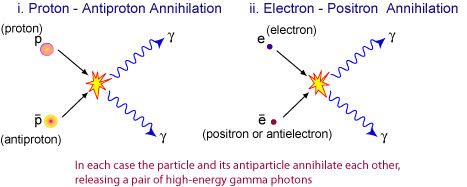Antiparticles
Positrons
⇒ Paul Dirac proposed the existence of positrons in 1928
⇒ A positron is the antiparticle of the electron - it has the same mass as an electron and a numerically equal but positive charge
Particles and Antiparticles
⇒ All particles have a corresponding antiparticle
⇒ Because particle and antiparticle pairs have the same mass, they also have the same rest mass-energy
- Rest mass-energy is the energy that is stored inside a stationary particle as a result of its mass
- Rest mass-energy implied that mass is simply another form of energy
- In fact, experiments readily show that mass can be converted to energy (nuclear decay) and energy can be converted to mass (photon-pair production)
⇒ Although a positron has its own distinct name, most antiparticles do not have a distinct name and are usually named by placing 'anti-' before the particle's name
⇒ Some other antiparticles include antineutrons, antiprotons, and antineutrinos
⇒ The symbol for antiparticles is usually the same as the symbol used for the particle itself, excpet it has a bar over the top of it. For example, see the table below:

⇒ An exception to this general rule is the positron, which usually uses a plus sign instead:

⇒ Other exceptions include the particle-antiparticle pairs for muons, pions, and kaons.
Antiparticles in the universe
⇒ Antiparticles are not that common
⇒ Our universe seems to be primarily made up of matter, and we only really see antiparticles in high-energy particle interactions
- For example, when high-energy cosmic rays interact with the atmosphere or particles are accelerated in the Large Hadron Collider
Particle-antiparticle interaction
⇒ When a particle and its corresponding antiparticle meet they annihilate each other
- This means that the total mass of the particle and antiparticle together will be converted into energy, in the form of two gamma ray photons

⇒ Two gamma ray photons must be produced in order to conserve momentum and the combined energy of these two gamma ray photons is equal to the rest energies of the particle-antiparticle pair in order to conserve energy
Pair Production
⇒ The opposite of annihilation is pair production
⇒ During pair production, an electon with sufficient energy can interact with a large nucleus and be converted directly into a particle-antiparticle pair
⇒ As the rest energy of an electron (and, therefore, a positron) is 0.51 MeV (i.e. 8.2 x 10-14 J), so if a photon was to create an electron-positron pair it would need to have enough energy to create both particles (i.e. 2 x 0.51 MeV)
⇒ Mega Electron-Volts (MeV) are used to measure the energy of nuclear particles - they are equivalent to 1.6 x 10-13 J
Positron Emission
⇒ Positron emission occurs when a proton changes into a neutron in an unstable nucleus with too many protons

⇒ Positron-emitting isotopes are not natural and are created by firing protons at a stable isotope until some protons are absorbed and it becomes an unstable positron-emitter